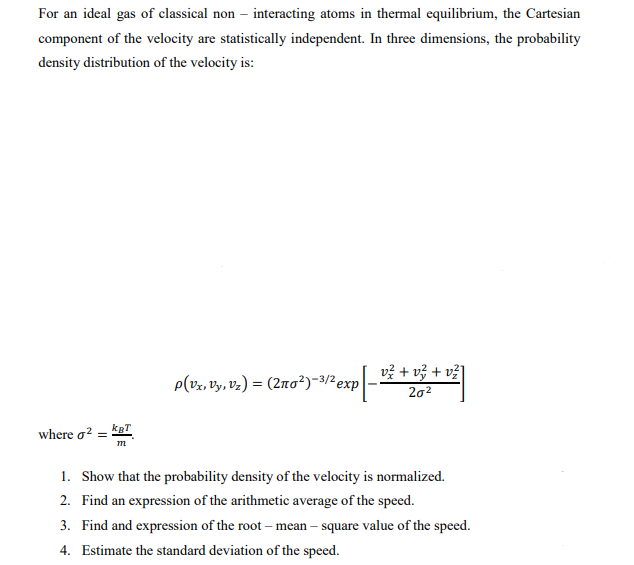For an ideal gas of classical non- interacting atoms in thermal equilibrium, the Cartesian component of the velocity are statistically independent. In three dimensions, the probability density distribution of the velocity is: where σ² = КВТ m P(Vx, Vy, Vz) = (2nо²)-³/² exp 20² 1. Show that the probability density of the velocity is normalized. 2. Find an expression of the arithmetic average of the speed. 3. Find and expression of the root - mean-square value of the speed. 4. Estimate the standard deviation of the speed.
For an ideal gas of classical non- interacting atoms in thermal equilibrium, the Cartesian component of the velocity are statistically independent. In three dimensions, the probability density distribution of the velocity is: where σ² = КВТ m P(Vx, Vy, Vz) = (2nо²)-³/² exp 20² 1. Show that the probability density of the velocity is normalized. 2. Find an expression of the arithmetic average of the speed. 3. Find and expression of the root - mean-square value of the speed. 4. Estimate the standard deviation of the speed.
Related questions
Question

Transcribed Image Text:For an ideal gas of classical non- interacting atoms in thermal equilibrium, the Cartesian
component of the velocity are statistically independent. In three dimensions, the probability
density distribution of the velocity is:
where σ² =
kBT
m
P(Vx, Vy, Vz) = (2nо²)-³/² exp
20²
1. Show that the probability density of the velocity is normalized.
2. Find an expression of the arithmetic average of the speed.
3. Find and expression of the root-mean-square value of the speed.
4. Estimate the standard deviation of the speed.
Expert Solution
This question has been solved!
Explore an expertly crafted, step-by-step solution for a thorough understanding of key concepts.
Step by step
Solved in 4 steps with 4 images
